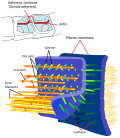Cadherin
Cadherin refers to a class of type II transmembrane proteins that play a crucial role in cell adhesion, ensuring that cells within tissues are bound together. These proteins are dependent on calcium ions (Ca2+) to function, which is why they are often referred to as calcium-dependent adhesion molecules. Cadherins are pivotal in the development and maintenance of tissue architecture and cell signaling, influencing processes such as morphogenesis, cell migration, and wound healing.
Structure and Function[edit]
Cadherins are characterized by their extracellular domain, which comprises repeated cadherin motifs that facilitate homophilic binding (binding to the same type of cadherin on adjacent cells). This interaction is calcium-dependent, requiring the presence of calcium ions to stabilize the cadherin structure and promote adhesion. The intracellular domain of cadherins interacts with catenins, a group of proteins that link cadherins to the actin cytoskeleton, providing mechanical strength to the cell-cell junctions.
There are several types of cadherins found in the body, including E-cadherin (epithelial), N-cadherin (neural), and P-cadherin (placental), each with a specific tissue distribution and function. E-cadherin, for example, is crucial for the maintenance of epithelial cell layers, while N-cadherin is important in the nervous system.
Role in Disease[edit]
Alterations in cadherin expression or function can lead to a variety of diseases. For instance, the loss of E-cadherin expression is a hallmark of epithelial-mesenchymal transition (EMT), a process implicated in cancer progression and metastasis. Similarly, mutations in cadherin genes have been linked to genetic disorders such as hereditary diffuse gastric cancer and arrhythmogenic right ventricular cardiomyopathy.
Research and Therapeutic Implications[edit]
Given their central role in cell adhesion and signaling, cadherins are a focus of research for developing therapeutic interventions in cancer and other diseases. Strategies to modulate cadherin function include the use of monoclonal antibodies, peptides, and small molecule inhibitors that can either promote or inhibit cadherin-mediated adhesion.
See Also[edit]
References[edit]
<references/>
-
Adherens Junctions structural proteins
-
Protocadherins
-
E-Cadherin repeating unit
Ad. Transform your life with W8MD's Budget GLP-1 injections from $75


W8MD offers a medical weight loss program to lose weight in Philadelphia. Our physician-supervised medical weight loss provides:
- Weight loss injections in NYC (generic and brand names):
- Zepbound / Mounjaro, Wegovy / Ozempic, Saxenda
- Most insurances accepted or discounted self-pay rates. We will obtain insurance prior authorizations if needed.
- Generic GLP1 weight loss injections from $75 for the starting dose.
- Also offer prescription weight loss medications including Phentermine, Qsymia, Diethylpropion, Contrave etc.
NYC weight loss doctor appointmentsNYC weight loss doctor appointments
Start your NYC weight loss journey today at our NYC medical weight loss and Philadelphia medical weight loss clinics.
- Call 718-946-5500 to lose weight in NYC or for medical weight loss in Philadelphia 215-676-2334.
- Tags:NYC medical weight loss, Philadelphia lose weight Zepbound NYC, Budget GLP1 weight loss injections, Wegovy Philadelphia, Wegovy NYC, Philadelphia medical weight loss, Brookly weight loss and Wegovy NYC
|
WikiMD's Wellness Encyclopedia |
| Let Food Be Thy Medicine Medicine Thy Food - Hippocrates |
Medical Disclaimer: WikiMD is not a substitute for professional medical advice. The information on WikiMD is provided as an information resource only, may be incorrect, outdated or misleading, and is not to be used or relied on for any diagnostic or treatment purposes. Please consult your health care provider before making any healthcare decisions or for guidance about a specific medical condition. WikiMD expressly disclaims responsibility, and shall have no liability, for any damages, loss, injury, or liability whatsoever suffered as a result of your reliance on the information contained in this site. By visiting this site you agree to the foregoing terms and conditions, which may from time to time be changed or supplemented by WikiMD. If you do not agree to the foregoing terms and conditions, you should not enter or use this site. See full disclaimer.
Credits:Most images are courtesy of Wikimedia commons, and templates, categories Wikipedia, licensed under CC BY SA or similar.
Translate this page: - East Asian
中文,
日本,
한국어,
South Asian
हिन्दी,
தமிழ்,
తెలుగు,
Urdu,
ಕನ್ನಡ,
Southeast Asian
Indonesian,
Vietnamese,
Thai,
မြန်မာဘာသာ,
বাংলা
European
español,
Deutsch,
français,
Greek,
português do Brasil,
polski,
română,
русский,
Nederlands,
norsk,
svenska,
suomi,
Italian
Middle Eastern & African
عربى,
Turkish,
Persian,
Hebrew,
Afrikaans,
isiZulu,
Kiswahili,
Other
Bulgarian,
Hungarian,
Czech,
Swedish,
മലയാളം,
मराठी,
ਪੰਜਾਬੀ,
ગુજરાતી,
Portuguese,
Ukrainian



